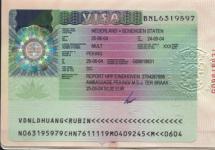| Question | Answer |
| It has become more convenient to rest for a short period of time. | |
| on trips; arbitrarily; planning; · control. |
|
| It is necessary to remember the exact dates of previous trips and know the future ones. | |
| Each country has its own punishment, which is determined by a police officer or border guard. Either way, it's against the law. | |
| You need to follow the link to the visa calculator on the embassy website and enter the required data. | |
| simplicity of calculation; the possibility of staying up to 90 days without leaving; comfort when planning a vacation and buying tickets in advance. |
Several years have passed since the introduction of new rules for calculating the duration of stay in the Schengen area on a tourist visa, but many travelers still find this decision puzzling and regretting.
The new method has become more convenient for those who visit Europe for short periods several times a year, and are cursed by those who have real estate there, for example, in Spain, in order to spend the warm half of the year there.
A Schengen multi-visa issued for a period of 6 months or more gives the right to stay in the Schengen area for up to 90 days within any arbitrary period of 180 days.Attention! Below is an online calculator for the Schengen area, please read on!
Tourists are invited to use an online calculator to correctly calculate the number of days that can be spent in the Schengen area on a tourist visa.
It is best to trace the differences in methods between the old and the new approach with an example.
So, conditionally, a Russian tourist has a Schengen visa for one year from January 1 to December 31, 2019. He spent the January holidays in the Czech Republic (10 days), celebrated Valentine's Day in Paris (4 days), now he would like to devote the beginning of May (from 1 to 15) to the study of Austria, but at the same time he has a trip planned in August (from 1 to 30 ) to Spain.
Old calculation rules
Previously, a traveler, having received a Schengen annual visa, could spend up to 90 days in Europe inclusive within 6 months or 180 per year (90/180 and 180/365). To check whether everything is in order with the deadlines, it was enough to manually calculate from the passport how many days were spent in the Schengen zone for a period of 180 days, i.e. until June 29: 180-10-4=66. This means that he has 66 days until June 29 (the balance is canceled) and another 90 in the second half of the year until December 31.

Those who had real estate or wanted to live longer in Europe did it easier - they came from April 1 to September 28 or from February 1 to May 31, or for any three months.
Advantages of the old rules:
- ease of manual calculation - adding 10, 4, 15, etc. is easier and faster than entering dates in an online Schengen visa calculator;
- the opportunity to stay 90 days without leaving;
- convenient when planning a vacation and buying tickets in advance.
- having spent 180/365, I had to wait 6 months to visit European countries again.
New calculation procedure
In 2013, the rules changed, the concept of a “visa calculator” was introduced. From now on, the tourist will have to turn to an online assistant before each trip to the Schengen countries in order to plan everything correctly.

The conditions 90/180 and 180/365 remained the same, the emphasis shifted to the date of departure from the Schengen area.
So, before the May vacation, a tourist needs to know exactly this date, for example, May 15th. Now from May 15, and not from the middle of the visa term, 180 days will have to be counted, it will be November 17, 2019. Then, for your next trip to Spain in August, you need to count 180 days ago from the final day of vacation, for example, on August 31 and add up all the days of your stay in this territory again.
It turns out that the beginning of the 180-day period - a key concept for holders of tourist Schengen visas - becomes mobile, "floating". It changes depending on the end of the trip.
Benefits of the new rules:
- It has become more convenient to rest for a short time - the exhausted period ends faster.
- you need to remember the exact dates of old trips and for sure know the new ones, although the same data will still have to be indicated in the questionnaire.
You can argue how it was better and more convenient, but the essence will not change, the new rules are mandatory for all tourists.
How to calculate the number of days
You can find out how many days are left in the Schengen area by manually calculating it, or using an online calculator.

To do this, you need to find a link to a visa calculator on the embassy website, open it. You will see 3 blocks:
- previous trips (here you must enter data on those that have already taken place - 01/01/2018–01/10/2018, 02/12/2018–02/16/2018, 05/01/2018–05/15/2018);
- estimated vacation date (05/15/2018);
- mark "planning";
- do the same with trips.
Travel mode
If you mark it, the calculator will calculate the number of days that have already been spent in the Schengen area and the remaining ones.
Random mode
Means that vacation dates can be entered not in order, but as convenient.
Planning mode
Allows you to schedule future trips, to imagine how many days after each will remain.
Control mode
Introduced in order to quickly and reliably check your Schengen days - check everything is in order if the vacation ends on a specific date.
Let's take an annual visa as an example. A tourist, thinking where and how much to rest, must enter his January, February and May vacation, choose "planning" and "date of entry" on August 1. The system will determine how many days he can stay in Spain.
Online calculator here
If you enter all the same travel dates, just mark “control”, then enter the day of departure, i.e. the end of August, on the corresponding “date” - the system will calculate whether there will be violations.
How long and where can you stay in the Schengen area for different types of visas
If you carefully study the document itself, it becomes interesting: what do the letters and numbers on it mean? Or how do border guards understand for what purpose and for how long the trip is carried out? Everything is very simple!

Schengen visas are classified as:
- by the number of times of use:
- single;
- double;
- multiple.
- by territorial action:
- category A - without leaving the airport transit zone;
- B - implies transit through the country for no more than five days;
- C - tourist with a certain period of stay in the Schengen area;
- C1 - up to 30 days;
- C2 - from 31 to 90 days;
- C3 up to 90 days multiple;
- C4 - similar, for a period of 5 years;
- category D - national, allowing long-term residence in only one country.
So, the border guard, having seen the C4 visa, understands that the traveler can stay on the territory of the Schengen countries for up to 90 days in half a year, he has the right to enter many times. In addition, this person had good reasons for requesting a five-year visa at the embassy.
Sanctions for violation of the regime of stay: is it worth the risk
Willy-nilly, but many tourists exceed the number of allowed days in the Schengen area, spending a little more than the prescribed period. And it is not so important what they are guided by in their actions: banal inattention, relying on chance or really got into a difficult situation, the result is one - a violation of the law.

The complexity of an overdue Schengen visa is a new term that explains the essence of the phenomenon. It consists in the fact that:
- each country has a different attitude towards visa violators, for example, Poland is strict, and Spain is more loyal;
- there are no clear criteria - any case is considered individually by the border guard or police officer, and the punishment can vary significantly;
- the task of monitoring the number of days is entrusted to the tourist himself.
That is why the sanctions for violating the regime are different: from a warning and a fine to deportation and subsequent quarantine. They depend on the circumstances of the event, the number of days, the position and behavior of the tourist, the availability of insurance for this period, and many more factors.
If a person incorrectly calculated his European vacation, exceeding it by several days, then, from the point of view of the law, such a person is certainly considered a violator and he faces punishment:
- they can point out a problem and advise not to do it again - this is a warning;
- issue or send by mail to the home address a receipt for paying the fine, its size can range from a small amount in euros to several thousand;
- can be immediately deported from the Schengen area - deported;
- as a measure, they may choose a temporary ban on entry into the country (quarantine), most often in the one where the violation was detected for a period of three months to five years.
In practice, punishment is often combined - a fine is issued and quarantine is imposed.
For example, a tourist by car travels to several countries of the Schengen zone, accidentally violates the period of stay and only at the border of Poland - Belarus learns about it from the border guard. In this case, most likely, the punishment will be several hundred zlotys and quarantine for entry into Poland for 3-6 months.

Either in the Czech Republic, when registering at a hotel or independently at the police, it turns out that on the previous trip the tourist stayed a day more than expected - probably the Czechs will issue a fine of 500 kroons.
It happens that a visitor grossly violated the terms of stay in the Schengen zone, did not have insurance, paid accommodation, tickets and was checked by the police in Austria. Then deportation and quarantine for 5 years are provided for him.
It is up to the traveler to decide whether it is worth the risk, it is enough to remember that one unsuccessful trip can forever change life for the worse.
What is important for a tourist:
- Do not succumb to the provocations of "knowledgeable and knowledgeable", who recommend leaving the loyal countries of the European Union in case of delay. Fraud can be revealed upon receipt of the next visa or the next trip, registration at the place of stay.
- If the plane is delayed, the car breaks down or gets to the hospital, as well as other force majeure situations, it is necessary to notify the embassy of a possible violation of the visa regime, contact the migration department of the police for foreigners and explain your case. Most likely, they will issue an appropriate document authorizing the excess.
- Carefully work with the online calculator, carefully entering the dates, print the result, if possible, and always explain your calculations to the border guards.



